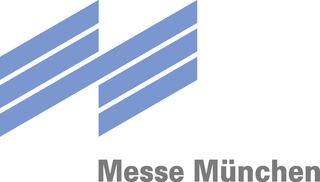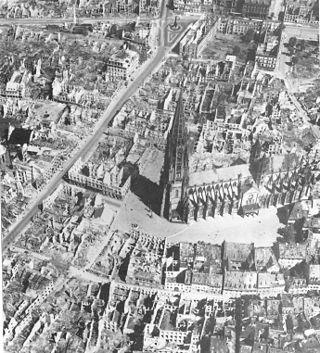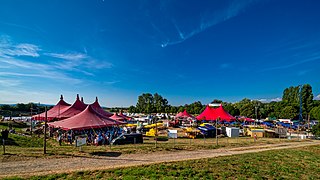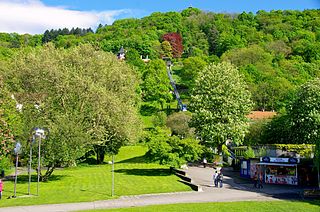| Headquarters | |
|---|---|
Key people | Bernd Dallmann, Klaus W. Seilnacht |
| Website | www.messe.freiburg.de |

Messe Freiburg (literally "Freiburg Trade Fair") is an event area and exhibition grounds in Freiburg im Breisgau.
| Headquarters | |
|---|---|
Key people | Bernd Dallmann, Klaus W. Seilnacht |
| Website | www.messe.freiburg.de |

Messe Freiburg (literally "Freiburg Trade Fair") is an event area and exhibition grounds in Freiburg im Breisgau.


Markets are undividedly connected to the history of the City of Freiburg. In the year 1120, the establishment of the city tumbled with the market rights. Conrad I, Duke of Zähringen shows all in all that the first fair was allowed to take place because of King Wenzel of Prague in 1379. Subsequently, Freiburg was on the International Commercial Centre on many occasions during this year. The Münsterplatz, and also the Stühlinger Kirchplatz, used for leisure activities, were very important centres. Between 1885 and 1914, at least six "people shows" (human zoo) ethnological expositions took place because of the spring and autumn fairs in Freiburg, which were dedicated to people from Africa and Sri Lanka (previously named as Ceylon). [1] The current ancient fair ground was inaugurated in the east of Freiburg in 1929. This had been used in the past for sporting events. The civic hall, situated on the Schwarzwaldstraße, was established to the east of the ancient fairground in 1954. This was according to the designs of Albert Maria Lehr. In the five decades that followed, the civic hall was used for social events, festivities, concerts, exhibitions and fairs. It was used as the provisional University Library from autumn 2008 until the new UB was completed in July 2015. Since the end of 2015, it served as emergency accommodation for refugees. [2] In the meantime, the hall is under the protection of historic buildings and monuments. [3]
The decision to move the Messe to the north of Freiburg was made in the nineties. The first construction stage, together with its three halls, was made up of 18,500 m² of floor space and service areas and was only implemented after just short of one and a half years. On January 17, 2000, three years after the appropriate municipal council resolution, the construction stage was put into action. Due to the relocation of the Messe, building sites emerged on the “Alten Messplatz”. These enriched the current surrounding areas of Wiehre, Oberau, Waldsee and Littenweiler, including 180 new residences and a huge shopping centre (Zentrum Oberwiehre). [4] [5]
The first public festival took place in autumn 1999 on the new outdoor area known as the "Freiburger Herbstmesse". Due to the investment of 75 million Euros, Freiburg had four times more exhibition space at its disposal than before. Cultural events can now take place in hall 2 with up to 10 000 viewers. On March 25, 2003, the local council in Freiburg decided to build a fourth hall: the Rothaus-Arena. In November 2004, the construction began. The country supported the second construction phase of the Messe with a grant of 2,9 million Euros from the promotion program for investmenting in exhibitions. The total investment for the fourth hall was around 22,9 million Euros, which was predominantly provided by regional companies. The designs for the construction of the first three halls, subsequently the Rothaus-Arena and the expansion of its foyer were award-winning, making it an achievement for the architect, Detlef Sacker, who is from Freiburg. [6] The new hall was inaugurated in 2006 as “Intersolar”, where the singer Pink made her appearance at the International Trade Fair.
The first construction stage, as well as the necessary connections to the roads and local public transport, including any further costs were paid with around 12,5 million Euros by the Badische Staatsbrauerei Rothaus. 4 million Euros came directly from the state Baden-Württemberg. Another 7 million came into the city treasury through selling property to the state Baden-Württemberg, which was used for expanding the University. The city invested more than 10,5 million Euros in creating the Messe Freiburg. Through the commercialization of the old trade fair in the east of the city, on which a new part of town and a shopping center were built, 12 million Euros were generated. The city paid more than 9 million Euros for the external development of the new trade fair and the demoliting of the buildings in the old location. The federal government and the state of Baden-Württemberg paid roughly 10 million Euros. All plans concerning the costs and schedule were kept.
The estimated doubling of the trade fair revenue to six million Euros by 2010 was exceeded in 2007 with more than 7,9 million Euros, and in 2010 with 15 million Euros. The indirect profitability of the Freiburg economy, trade and gastronomy, which was generated by the new trade fair, had tripled to 60 million Euros per year during this time. The biggest events in the last decades included: the Tour de France in 2000, an open-air concert by Herbert Grönemeyer with 54000 visitors, the visit of the 14th Dalai Lama, several TV-shows (Wetten, dass..?, Verstehen Sie Spaß?, Musikantenstadl,...), the world championships of indoor cycling (in 2005) and roller figure skating. The number of days when the trade fair was occupied rose from roughly 220 to 330 between 2005 and 2007. The revenue per employee of the Messe Freiburg is by now the highest in the country.
Pope Benedict XVI held a vigil mass on 24 September 2011, together with 28,000 adolescents on the exhibition ground of the Freiburg Messe, as part of his visit to Germany in 2011.
[7]

The Messe Freiburg is situated 2.5 km northwest of the Freiburg Old Town and is in close vicinity to the airfield, the goods station, parts of the University of Freiburg, the University Medical Center and the Industrial Area in the North (Industriegebiet Nord). The Messe Freiburg is connected to the city center by the Breisgau-S-Bahn, with the station Neue "Messe/Universität", and since December 2015, by the tram-line 4 used as a part of the Freiburg city railway. The tram-line 4 will be extended by two stations by 2017. In the future the final stop will be "Madisonalle". 4000 Parking spaces are available for visitors who arrive by car.
According to its website, the Messe Freiburg is equipped with four halls, each with an area ranging between 2.400 m² and 4.800 m², totaling up to 21,500 m². [8] Additionally there are 11 conference rooms that can hold up to 420 people, 14 offices are available for rent, as well as an outdoor area of roughly 80.000 m². The area is used to host folk festivals, open-air concerts and exhibitions; it is also available for parking. The catering area contains three food stalls and a restaurant. Exhibition hall 4 is known as "Rothaus-Arena"; it is used as a concert hall, therefore there are adjustable bleachers as well as several seating arrangements. It provides standing room for up to 9,000 people.
In 2006, the company "Goldbeck Solar GmbH" provided a photovoltaic system with an output of 254 kilowatt-peak (kWp) for the Rothaus Arena's 6.500 m² flat roof. [9] The 1.210 solar panels are supposed to generate about 235.000 kilowatt hours of renewable energy per year. In combination with the solar power system, installed by "S.A.G. Solarstrom AG" on another part of the Messe, the power generation may reach around 650 kWp in total.
In keeping with Freiburg's traditions, a Bächle and several cobblestone mosaics have been created.
The operating company of the Messe is "Freiburg Wirtschaft Touristik und Messe GmbH & Co. KG" (FWTM), which is under the absolute ownership of the City of Freiburg. The company was founded in 2005 when the separate corporations "Messe Freiburg" and "Freiburg Wirtschaft & Touristik GmbH & Co. KG" (FWT) merged. The FWTM also runs the Freiburg Konzerthaus and several other venues. It is in charge of the economic development and promotion of tourism as well. The FWTM's business executives are Dr. Bernd Dallmann and Klaus W. Seilnacht. The chairman of the board is Dr. Dieter Salomon, the mayor of Freiburg and a member of the Alliance '90/The Greens.
The events and fairs at the Messe Freiburg attract approximately 400,000 visitors each year. The number of events increased from 72 per year in 2002 to over 100 in 2008.
Since the very beginning, the trade fair "Intersolar" has been essential for the economic success of the Messe Freiburg. Thanks to newly created infrastructure, Intersolar had been moved from Pforzheim to Freiburg in 2000, where it is still organized, even after relocating to Munich because of its growing size, under the direction of the FWTM and their partner "Solar Promotion". Today Intersolar represents the FWTM in the US and in India. It generates more than half of the Messe Freiburg's turnover. Apart from Intersolar, the leading trade fair in the brush industry "INTERbrossa-BRUSHexpo" (Interbrush) takes place in Freiburg every four years.
In the field of consumer fairs, the Messe Freiburg increasingly focuses its own events on special-interest fairs such as the connoisseur fair "Plaza Culinaria", the "International Kulturbörse", the construction fair "Gebäude Energie Technik", or the property fair "IMMO". Furthermore, there are the traditional "Baden-Messe", the "CFT - Camping, Freizeit und Touristik", the "Automobil", the "Modellbau" as well as two second-hand car fairs and numerous guest shows. Twice a year, there is the "Freiburger Mess" held on the open-air grounds. It is the largest funfair in the region and attracts up to 170,000 visitors. Additionally, there are various markets, circuses and conventions.

Freiburg im Breisgau, commonly referred to as Freiburg, is an independent city in Baden-Württemberg, Germany. With a population of about 230,000, Freiburg is the fourth-largest city in Baden-Württemberg after Stuttgart, Mannheim, and Karlsruhe. The Freiburg built-up area had a population of 354,500 (2021). The population of the greater Freiburg metropolitan area ("Einzugsgebiet") was 656,753 in 2018. In the south-west of the country, it straddles the Dreisam river, at the foot of the Schlossberg.

Dieter Salomon is a German politician of Alliance '90/The Greens who served as mayor of Freiburg im Breisgau for two terms from 2002 until 2018.

Dreisamstadion is a football stadium in Freiburg, Baden-Württemberg, Germany. It was formerly the home of Bundesliga team SC Freiburg between 1954 and 2021, until a new stadium — the Europa-Park Stadion — was built in October 2021. The stadium holds 24,000 spectators and was built in 1953. It is situated near the Dreisam river, for which it is named.

Badische Staatsbrauerei Rothaus is a brewery owned by the German state of Baden-Württemberg. Rothaus, at the northern edge of the village of Grafenhausen in the southern Black Forest, is one of Germany's most successful and profitable regional breweries.

The University Library Freiburg is the library of the University of Freiburg. As an academic and research library, it caters to students and staff of the University of Freiburg, the University of Education Freiburg, the Catholic University of Applied Sciences Freiburg, and the Protestant University of Applied Sciences Freiburg. The library is open to interested members of the public as well.

Freiburg Hauptbahnhof is the central railway station of the German city of Freiburg im Breisgau. The Rhine Valley Railway (Mannheim–Basel), Höllentalbahn and the Breisach Railway (Breisach–Freiburg) meet here.

The Freiburg–Colmar railway was an international railway that formerly connected Freiburg im Breisgau, in the German state of Baden-Württemberg, with Colmar, in the French department of Haut-Rhin. The line crossed the river Rhine on a bridge between Breisach and Neuf-Brisach. Since that bridge was destroyed in 1945, the line from Freiburg has terminated at Breisach, and this stretch of line is now commonly called the Freiburg–Breisach railway, or the Breisacherbahn. The section from Freiburg to Breisach was completed in 1871 and the remainder in 1878.

The Freiburg im Breisgau tramway network is a network of tramways that forms part of the public transport system in Freiburg im Breisgau, a city in the federal state of Baden-Württemberg, Germany. Established in 1901, the network has been operated since its foundation by the company now known as Freiburger Verkehrs, and powered by electricity. The tramway network currently has five lines. The expansion of the tram network since 1980 has served as an example of the "renaissance of the trams" in Germany. As of 2023, 73 trams were available for regular use: 2 of these were high-floored, 36 partial and 35 low-floored. Almost the entirety of the network is located within Freiburg's urban area; only a few metres of the balloon loop at Gundelfinger Straße are located outside the boundary of Gundelfingen to the north of Freiburg. In total, the trams serve 20 out of the 28 districts in Freiburg.

Messe München GmbH is the operator of the Neue Messe München exhibition center, the ICM Internationales Congress Center München and the MOC Veranstaltungscenter München. The exhibition space of the 16 halls together is 180,000 m2 and another 425,000 m2 of outdoor area, making Messe München by far the holder of the largest outdoor area of all exhibition companies in Germany. Messe München organizes some 40 trade fairs for capital and consumer goods and key high-tech-industries in Munich and abroad.

The Bertoldsbrunnen is a monument in the historic city of Freiburg im Breisgau. It is situated at the crossing of the Salz- and Bertoldsstraße with the Kaiser-Joseph-Straße. The fountain is one of the central locations of the city. A tram station with the same name is situated at the Bertoldsbrunnen where four of the five tramways of the Freiburger Verkehrs AG stop.

The Minster Square in the centre district of Freiburg, Germany, is a paved area surrounding the Freiburger Minster. The city library, the Historical Merchants' Hall, the Wentzinger House and the Korn House are on this square. The Freiburger streams run along the sides of the square.

The Zelt-Musik-Festival (ZMF) has taken place every June and July since 1983 in Freiburg im Breisgau, Germany. It lasts three weeks and counts up to 120,000 visitors each year. The program is very broad. There is music, art, theater, cabaret and sport in different tents and on open-air stages. According to the organizer it is the biggest and oldest music festival in Baden-Württemberg. Over the years, more than 600 regional and international artists offered a diverse program consisting of classic, jazz, rock, pop and world music, cabaret and children's program. Also, many newcomers have been promoted.

Freiburg im Breisgau's parks, green spaces, recreational facilities, playgrounds, roadside greeneries and the Mundenhof add up to an area of 397 ha (3.97 km2), which corresponds to 18.05 m2 of green space per Freiburg citizen. On average, major cities in Baden-Württemberg have 22.66 m2 green space/citizen. However, there is an area of 2600 ha (26 km2) of forest in the close proximity of Freiburg as well as additional recreational area like the Rieselfeld district. The majority of the green spaces came into existence from the 1960s on.

The Colombischlössle is a manor house in the city centre of Freiburg im Breisgau where the eponymous archaeological museum is situated.

The Stadtgarten of Freiburg is a 2.6 ha park within the Neuburg district. It has an old tree grove and a large rose garden, and lies between the Leopoldring, Jackob Burckhardt, Ludwig and Mozart streets near Freiburg's city centre. It is connected to Karlsplatz via the Karlssteg footbridge, which is made from pre-stressed concrete. Since 2008 the Schlossberg Tram, an inclined elevator, leads up to Schlossberg. It replaced the Schlossberg Cable Car built in 1968.
Mooswald is a district in the western part of Freiburg im Breisgau, which consists of the two districts Mooswald West (521) and Mooswald East (522). Its population is 9,223 (2020). In the North East, Mooswald borders the district of Brühl, with its airfield, the university campus of the technical faculty and the exhibition centre. Mooswald further borders the district of Landwasser in the North West, the district of Stühlinger in the East and the district of Betzenhausen with the Seepark in the South West. Mooswald is separated from Brühl by the Breisgau S-Bahn, from Landwasser by the Westrandstraße (Paduaallee/Mooswaldallee) and from Stühlinger by the railway tracks of the freight railway.

The Platz der Alten Synagogue is a square in Freiburg, Germany. With a size of 130 square metres, it is the second largest square in the city after Minster Square. The square is named after the old synagogue, which was destroyed during the Kristallnacht in 1938. The synagogue had been built in 1869/1870 to the southwest of today's location of the square.

Wiwilíbrücke is a bridge of the German city Freiburg im Breisgau which is also called Blaue Brücke because of its paint and it had formerly been called Stühlingerbücke before the new Stühlingerbücke was built for the tramway. The bridge connects the city’s district Stühlinger to the old town as it links the church square of Herz-Jesu-Kirche to Konrad-Adenauer-Platz in spanning the railway tracks of Freiburg Hauptbahnhof. Today, Wiwilíbrücke is a listed building and is used by up to 10,000 cyclists per day.

The Europa-Park Stadion, also known as the Mooswaldstadion by fans, is a football stadium in Freiburg, Germany. It primarily serves as the home stadium of SC Freiburg, replacing the club's former home, the Dreisamstadion. It is located in a part of the city called Brühl, immediately to the west of Freiburg Airport.

Tbe Kongresszentrum Karlsruhe, located in Karlsruhe, Baden-Württemberg, Germany is the largest inner-city congress centre in Germany, operated by the Karlsruher Messe- und Kongress GmbH. It is located within walking distance of the main railway station and comprises about 20,000 m2 (220,000 sq ft) of exhibition space in four halls arranged around the 10,000 m2 (110,000 sq ft) Festplatz.